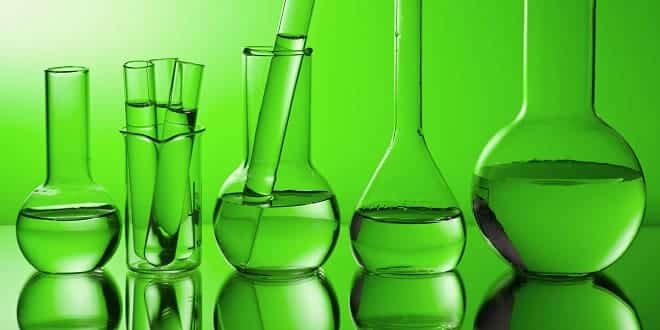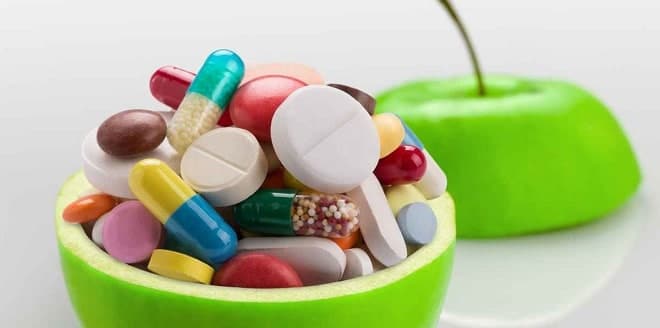Vitamins & Minerals ( Prof.Dr. Fahrettin GÖĞÜŞ )
Vitamins and Minerals
Vitamins and minerals are micronutrients. They provide no caloric value, but are essential for
• normal growth,
• functioning and
• maintenance of the human body.
Recommended Dietary Allowance (RDA)
The average daily dietary nutrient intake level sufficient to meet the nutrient requirements of nearly all (97%-98%) healthy individuals in a particular life stage and gender group.
The RDA is derived from (i) the individual variability, and (ii) the nutrient bio-availability from the habitual diet.
Sources and Functions
Vitamins
Term vitamin is a combination of words vital and amine. Originally, it was thought that vitamins are nitrogen containing amines necessary for life. Since then, many vitamins have been discovered that are not amines.
Essential daily requirements of vitamins are very small, usually few milligrams (mg) or even micrograms (μg). Most vitamins cannot be produced by our bodies and have to be provided in the diet.
Exceptions are vitamin D that is produced when skin is exposed to the sunlight and vitamin B3 (niacin) that can be synthesized in small amounts from amino acid, tryptophan. Insufficient amount of vitamins in the diet will cause negative symptoms that can lead to vitamin deficiency diseases.
Vitamins have diverse biochemical functions.
Vitamin D has hormone-like functions regulating mineral metabolism.
Vitamin A acts as the regulator of the cell and tissue growth and differentiation.
Vitamins E and C function as antioxidants.
The B complex vitamins function as enzyme cofactors (coenzymes) and help enzymes catalyze metabolic processes.
Vitamins are grouped into two categories:
• fat soluble
• water soluble
Lipid soluble vitamins have nonpolar structures and dissolve in fatty tissues. They include vitamins A, D, E, and K. These vitamins accumulate in the body fat and in the liver, thus, when taken in excess they can be toxic.
Vitamin A
Vitamin A include carotenoids (plant sources) and retinol (animal sources). Vitamin A is commonly known as the anti-infective vitamin, because it is required for normal functioning of the immune system.
Vitamin A deficiency causes vision impairment in a dim light (night blindness). Plants contain carotenoids, which are precursors of vitamin A (α-carotene and β-carotene). Yellow and orange vegetables contain significant quantities of carotenoids. The best sources of vitamin A are carrots, eggs, highly pigmented vegetables
Vitamin D
Vitamin D exists in many forms, but humans mainly utilize vitamin D3 (cholecalciferol). Vitamins D2 and D3 are referred collectively as vitamin D.
Vitamin D is unique since it is the only vitamin that our bodies can produce when exposed to the sunlight. An adequate exposure to sunlight can eliminate the requirement for the vitamin D in the diet, making it “conditionally essential.” Without vitamin D, there is an insufficient absorption of calcium and phosphorus from the food. Vitamin D deficiency may lead to rickets, tooth decay, softening of the bones, improper healing of fractures, lack of vigor, muscular weakness, inadequate absorption of calcium, and retention of phosphorous in the kidneys. Few foods contain vitamin D and those include some fatty fish (herring, salmon, and sardines), fish liver oils, and eggs.
Vitamin E
Vitamin E includes a family of eight antioxidants. Alpha- tocopherol is the only form of vitamin E that is actively maintained
in the human body. Vitamin E has many functions in the body: It mainly acts as an antioxidant of lipids, protecting cell membranes and preventing damage to the membrane enzymes. Vitamin E is a major antioxidant nutrient that slows down cellular aging due to the oxidation.
Major sources of α-tocopherol include vegetable oils (olive, sunflower, and safflower), nuts, whole grains, and green leafy vegetables. A high dietary intake of vitamin E may decrease risk of some cancers.
Vitamin K
Vitamin K is essential for the blood clotting. There are two naturally occurring forms of vitamin K. Plants synthesize vitamin K1 and bacteria synthesize vitamin K2.
Symptoms of vitamin K deficiency include easy bruising and bleeding, nosebleeds, bleeding gums, blood in the urine and stool, and extreme menstrual bleeding. Vitamin K deficiency is uncommon in healthy adults, but newborns that are exclusively breast-fed are at increased risk.
Vitamin K is present in most foods, but green leafy vegetables are the richest source. Bacterial synthesis in the bowel provides humans with vitamin K, in addition to the diet.
Water Soluble Vitamins
Water-soluble vitamins include the B complex vitamins and vitamin C.
Water soluble (hydrophilic) vitamins:
(1) are found in the watery parts of food;
(2) move directly into the blood after being absorbed;
(3) can travel freely in the blood;
(4) circulate in watery compartments of the body’s organelles;
(5) are easily excreted by the liver when in excess.
Vitamin B1
Vitamin B1 (Thiamin) is a white, crystalline solid, widely distributed in plants and animal tissues.
Thiamin can be destroyed by the cooking, especially by boiling.
Vitamin B1 needs to be regularly supplied since only little is stored in the liver, heart, and kidneys.
Excess of thiamin is eliminated with urine.
Deficiency of thiamin causes a condition known as beriberi. In certain parts of the world, lack of vitamin B1 in mother’s diet can cause deadly deficiency in infants.
Sunflower seeds, peanuts, wheat bran, beef liver, pork, seafood, egg-yolk, and beans are sources of thiamin.
Vitamin B2
Vitamin B2 (Riboflavin) is an orange-yellow crystalline substance resistant to heat, acids, and oxidation.
It is sensitive to sunlight and foods containing riboflavin need to be protected from it. Very little of vitamin B2 is lost during cooking.
Vitamin B2 deficiency most frequently occurs in people with long- standing infections, liver disease, and alcoholism. A sore throat and sores around mouth are the first symptoms of the deficiency, followed by anemia and impaired nerve functions.
Riboflavin is found in foods that contain other B vitamins. Brewer’s yeast is the richest natural source of the vitamin B2.
Vitamin B3
Vitamin B3 (Niacin/Vitamin PP) is a white crystalline substance, soluble in water and alcohol). It consists of nicotinic acid and nicotinamide.
Niacin is one of the most stable of the B vitamins. It is resistant to heat, light, air, acids, and alkalis.
Vitamin B3 deficiency can cause pellagra characterized by dermatitis, diarrhea, and dementia. The first sign of pellagra is skin sensitivity to light.
The main sources of vitamin B3 are liver, organ meats, poultry, fish, and peanuts.
Vitamin B5
Vitamin B5 (Pantothenic Acid) is essential to all forms of life.
Pantothenic acid is a yellow viscous oil usually in the form of calcium or sodium salts.
Vitamin B5 is resistant to oxidation and reduction. However, it is easily destroyed by acids, alkalis, and dry heat.
Vitamin B5 deficiency is unlikely, because it is widely distributed in foods.
Rich sources of pantothenic acid include liver, kidneys, yeast, egg yolk, and broccoli. Whole grains are also good sources of pantothenic acid, but processing grains may result in a 35%–75% loss. Freezing and canning of food results in similar losses.
Vitamin B6
Vitamin B6 (Pyridoxine) includes three related compounds: pyridoxine, pyridoxal, and pyridoxamine. Vitamin B6 must be supplied in the diet. So many functions are performed by pyridoxine that its deficiency affects the whole body.
Sources of vitamin B6 include brewer’s yeast, eggs, chicken, carrots, fish, liver, kidney, peas, wheat germ, and walnuts.
Vitamin B12 (Cobalamin) is named the “red vitamin,” as it is a red crystalline compound containing cobalt. Vitamin B12 is unique, because it contains an essential mineral cobalt.
Vitamin B12 deficiency affects the blood, energy level, mental state, and nervous system.
Vitamin B12 is present in meat, poultry, fish, and milk. It is not present in plants and yeast.
Folic acid
Folic acid is a common name of pteroylmonoglutamic acid. Folic acid is very sensitive and it is easily destroyed by light, heat, cooking, and acids. It can be lost when food is stored at room temperature for an extended time. Deficiency of folic acid can lead to a low birth weight and growth problems in infants. The main sources of folic acid are green leafy vegetables (foliage). It is also found in fruits, legumes, starchy vegetables, beans, whole grains, and liver.
Vitamin B7
Vitamin B7 (Biotin/Vitamin H) is one of the most stable of the B vitamins. Biotin is found in many foods, but in lower amounts than other water-soluble vitamins. It is difficult to obtain enough biotin from the diet, but intestinal bacteria (lactobacillin) produce biotin. Egg yolk, liver, and yeast are sources of biotin.
Vitamin C
Vitamin C (Ascorbic Acid) is essential for normal functioning of the body. Unlike most mammals, humans do not have the ability to make their vitamin C and it must be supplied in the diet.
Vitamin C is unstable and cooking can destroy it. Vitamin C is highly polar and it is readily soluble in aqueous solutions.
Vitamin C is also a highly effective antioxidant. It protects proteins, lipids, carbohydrates, and nucleic acids from the damage by free radicals and oxygen.
Severe vitamin C deficiency, scurvy, has been known for many centuries. Symptoms of scurvy include bleeding and bruising easily, hair and tooth loss, joint pain, and swelling.
The best sources of vitamin C are: the citrus fruits, oranges, lemons, limes, tangerines, grapefruits, peppers, broccoli, tomatoes, dark leafy greens, cabbage, and sauerkraut.
MINERALS
Minerals are inorganic ionic compounds that cannot be synthesized by the plants or animals.
The only source of minerals is diet. Soil, water, plants, animals, and humans all contain minerals. They are vital for human life.
Minerals often work with vitamins and protect the cells and keep bones, teeth, and skin healthy. They also play an important role in regulating the blood pressure, heart, muscle functions, and healing of wounds.
The minerals that we need in the largest quantity (hundreds of mg/day) are called major minerals. They include calcium, chlorine, magnesium, phosphorus, potassium, sodium, and sulfur. Our body will not function if any of these minerals is deficient.
…




